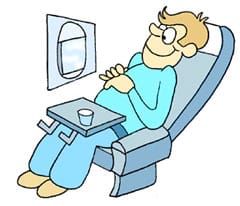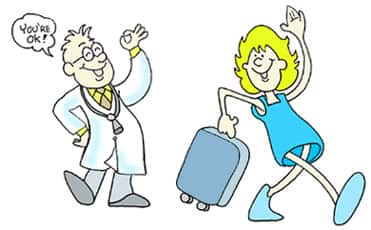| For a healthy and comfortable time on board, please note the following characteristics of the inflight environment and their possible health effects on health:
1. The Inflight Environment

Atmospheric pressure
During flights, cabin pressure is adjusted by air-conditioning but remains about 0.2-0.3 hPa lower than at sea level about equal to being on a mountain 2,000-2,500 meters high. It is said that the large pressure change that occurs 15-30 minutes after takeoff, and again before landing, may cause ear problems for some passengers who are not in good physical condition.
Temperature and humidity
Cabin temperature is set to 22-26 C. During long flights, cabin humidity tends to drop below 20% as the humidity of the air brought in from the outside is extremely low. Due to the dryness in the cabin, the body may dehydrate, causing nasal or throat pain as well as discomfort to contact lenses wearers.
Oxygen dilution
Along with the decrease in atmospheric pressure, the concentration of oxygen in the cabin decreases 20-30% (compared to sea level). While this is not a problem for most passengers, those suffering from respiratory diseases, cerebro-vascular disorders or serious anemia may be affected under certain, rare circumstances.
Motion
Airliners produce minimal vibration, but passengers who tend to feel nauseous in motor vehicles may suffer ill effects if the flight encounters turbulence. Because not all turbulence is foreseeable, we recommend that you keep your seatbelt fastened whenever you are in your seat.
Seating
When you remain seated in the same position for a prolonged period, veins in the feet and legs can become constricted. This in turn can lead to the formation of blood clots in the leg, also known as deep vein thrombosis (DVT).
DVT is not necessarily accompanied by any overt signs, and an expert opinion is needed to confirm the condition, but the following symptoms may occur: pain, swelling and discoloration of the leg, congestion of the superficial veins of the leg, or the leg feeling warm to the touch.
If a clot does build up, there is a risk that it may detach itself and travel to other parts of the body, such as the lung, where it can cause chest pain, shortness of breath and even sudden death. This may occur hours or even days after the clot's formation.
DVT is not related to class of air travel. It has wrongly been called 'Economy Class Syndrome', whereas in fact it can affect passengers in any cabin. Nor is it limited to air travel, as people sitting immobile in cars, trains or buses may also be at risk.
Some passengers are more prone to DVT than others, and if you have any health concerns, or if any of the following apply to you, you are advised to seek medical advice before flying:
 |
personal or family history of DVT and/or pulmonary embolism |
 |
recent major surgery |
 |
malignancy, previous or current |
 |
(known) thrombophilia |
 |
varicose veins |
 |
heart failure or recent myocardial infarction |
 |
hormone therapy, including the oral contraceptive pill |
 |
polycythemia, thrombocytosis |
 |
pregnancy or recent postpartum condition |
 |
recent injury, including limb fracture |
 |
recent immobilization for a day or more |
To reduce the risk of DVT, we recommend that all passengers follow the steps outlined in this leaflet, paying particular attention to the sections on exercise and drinking adequate fluids/ water. |










 If you are receiving medical care, be sure to consult your doctor when planning your flight. If you are not confident about your health due to a previous illness or chronic disease, we recommend that you take a medical check before your trip. We also recommend passengers in the late stages of pregnancy or those accompanying infants to consult their doctors. Furthermore, if you fall into any of the DVT risk categories
, please ask your doctor whether you are fit to travel and how DVT can be avoided.
If you are receiving medical care, be sure to consult your doctor when planning your flight. If you are not confident about your health due to a previous illness or chronic disease, we recommend that you take a medical check before your trip. We also recommend passengers in the late stages of pregnancy or those accompanying infants to consult their doctors. Furthermore, if you fall into any of the DVT risk categories
, please ask your doctor whether you are fit to travel and how DVT can be avoided.